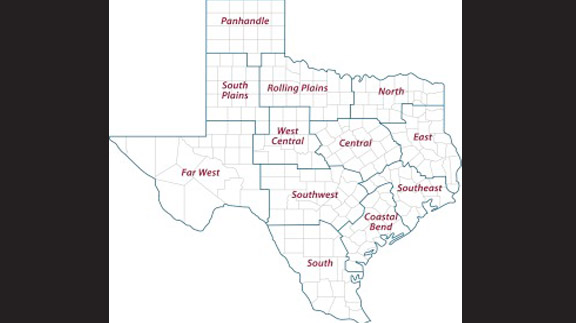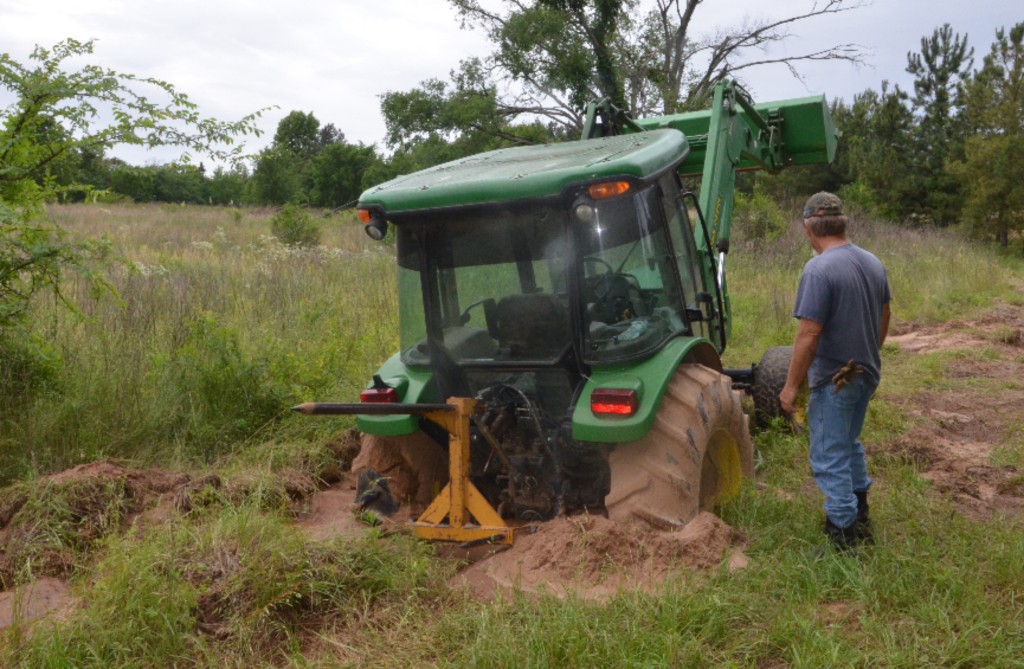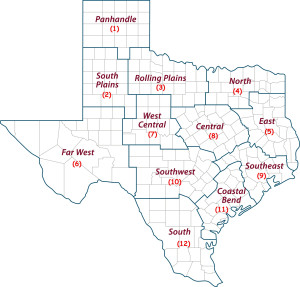Farm & Ranch
Texas crop, weather for May 12, 2015

By: Robert Burns
Rains continued to delay fieldwork, hay harvesting
Writer: Robert Burns, 903-834-6191, [email protected]
COLLEGE STATION – Rain continued to push back the drought, but producers in much of the eastern part of the state felt like they were being washed away, according to Texas A&M AgriLife Extension Service reports.
In the last seven days, all of the state received rain, with 6 to 10 inches or more coming to parts of East, North and South Texas. Three to 4 inches was common to these areas, according to the National Weather Service.
As a result of all the rain, only about 30 percent of the state was under moderate to exceptional drought, compared to 83 percent a year ago, according to the U.S. Drought Monitor.
The rains were also pushing feral hogs out of low-lying, flooded areas and into pastures and cropland, according to the agent reports.
“We have been receiving a lot of rain, so pastures have been too saturated for working,” said Shaniqua Davis, AgriLife Extension agent for Upshur County. “Many fungi have started occurring due to all the rain and pasture conditions.”
“Grass is tall, and some are cutting hay, while others want to, but fields are too wet to do so,” said Chad Gulley, AgriLife Extension agent for Smith County. “Cattle are in good condition and spring cattle work continues.”
“Pasture grasses are growing quickly because we’ve had so much moisture and warm weather,” said Armon Hewitt, AgriLife Extension agent for Trinity County. “But pastures are too wet to drive through for trucks and tractors alike. Erosion is becoming a problem in many places. Fertilizer is impossible to put out in most pastures as the spreader trucks with floatation tires are getting stuck.”
“This past week has brought a ton of rain to the county,” said Cody Maxwell, AgriLife Extension agent for Fannin County. “Wheat is headed out, looking good and starting to turn a little, but has been standing in water for most of last week.”
AgriLife Extension district reporters compiled the following summaries:
Central: Soil moisture, rangeland, pastures, crops and livestock all remained in good condition. Stock-water tanks were full, rivers were running and lake levels rising. Cows were fat and in good condition. Sorghum planting was behind schedule. The first pecan nut casebearers were found in traps. Bermuda grass looked good, the best in years. Hay will not be harvested until drier conditions arrived.
Coastal Bend: High winds dried out topsoil and discouraged forage producers from spraying for weeds. Some fertilizer was applied. Most crops were planted. A little wheat was harvested, but most was not mature yet. More rain could further delay harvests. Most cotton, grain and soybean fields looked good. Beef cattle were in good shape as calves were being worked. Pastures were in excellent condition, and limited hay harvesting began.
East: Fields and pastures remained saturated. Water sources were overflowing, even those that did not depend upon runoff water. Subsoil and topsoil were adequate to surplus. In most areas, pastures were too wet to drive through with trucks and tractors. Fly and other insect populations increased with sun and warmer weather. Fungus was occurring due to all the rain and pasture conditions in Upshur County. Vegetable growers were still having difficulty working fields. Hay crops needed to be harvested, but inadequate drying conditions have not allowed for harvest. Soil erosion was becoming a problem in many areas. A few producers were able to apply fertilizer and herbicides or harvest hay. Cattle were in good condition. The weaning and selling of market-ready calves and cull cows continued. Feral hog damages increased.
Far West: Andrews, Ward, Upton, Hudspeth and Pecos counties had heavy rains of from 1 inch to 3 inches, with flash flooding in some areas. Western Ward County received severe thunderstorms with golf-ball to tennis-ball size hail. Cattle were generally in good condition, with a few reports of problems with poisonous weeds. Pasture and rangeland conditions were better than average in most counties, with only Reagan and Presidio counties having grasses starting to dry out due to high winds and warmer days. The rains slowed cotton planting. Pecan trees were at full pollination. The second cutting of alfalfa was underway. Wildflowers and weeds were abundant this year due to substantial rain. Sorghum and oats were in fair condition. Winter wheat was in fair to poor condition, and corn and rice were in very poor condition. In most counties, subsoil and topsoil moisture were adequate to short. Rangeland and pastures were in fair t o good condition.
North: Topsoil moisture was adequate to surplus. Heavy rains on May 9 caused flooding in some areas, covering some roads in water and causing creeks to overflow. Wheat headed out and was looking good, despite some fields having standing water for most of the week. Because of the spring rains, many wheat producers had to apply fungicides to counteract both leaf and stripe rust. Corn was doing fairly well, but only about 30 percent of the total acreage allocated for corn had been planted because of the wet weather. Some grain sorghum was planted, but most of the unplanted corn acreage will lie fallow until next year. Hay producers were struggling to make a first cutting. Pastures were in good condition, as were livestock thanks to plentiful forages. Fly populations were increasing, and mosquito numbers were described as “horrific.”
Panhandle: Temperatures were near average, with most of the region receiving rain, from 1 inch to as much as 7 inches. Some areas received pea-sized hail. Farmers had to wait for soils to dry out to do fieldwork, including planting corn, which is as much as two weeks behind schedule. Some producers were able to plant corn in sandier soils. Wet conditions also slowed the harvesting of wheat silage and wheat hay. In Deaf Smith County, corn was about 50 to 60 percent planted, with planters left sitting at the end of the fields until things dry out. Very little cotton or grain sorghum had been planted either. Wheat was doing alright — if it wasn’t hit by hail storms, attacked by greenbugs or infested by diseases. There was still potential for a wheat crop if weather permits. There were several fields cut for hay, but with the recent rains it won’t be in condition to be baled anytime soon. Hemphill County received 8 to 15 inches countywide in most areas during the last several weeks. Nighttime temperatures were still too cool for good growth of warm-season grasses. Randall County received some hail with the rain, and some wheat fields in the southern portion of the county were totally wiped out. Rangeland and pastures benefited from all the recent rains and were greening up. Cows were beginning to regain the body condition they lost during the winter.
Rolling Plains: Rain continued to fall, with some counties reporting as much as 6 inches, along with high winds and some hail. The area had deep soil moisture for the first time in several years. The heavy rains stalled all fieldwork. Wheat, corn and sorghum producers were assessing crop damage from the heavy rains and hail. Most stock-water tanks were filled to overflowing. Lake levels rose. Livestock were generally in good to excellent condition. Producers were rebuilding herds. Pastures greened up with the growth of warm-season grasses. Some hay was baled, which was earlier than normal. Peach orchards were mostly undamaged by the storms.
South: Weather throughout most of the region was warm, dry and favorable for fieldwork. Many producers were able to do some planting, cultivating and harvesting. In the northern part of the region, corn, grain sorghum and winter wheat were progressing well. Wheat was maturing, corn was in the silk stage and cotton planting continued. Summer perennial grasses responded to the warmer soil temperatures, though improved pastures had heavy weed infestations. Cattle remained in good condition. Soil moisture conditions were mostly adequate throughout the northern counties. In the eastern part of the region, producers were able to plant some grain sorghum, peas and summer wheat. In Jim Wells County, wheat harvesting began. Planting remained at a standstill in Kleberg and Kenedy counties due to wet conditions. Rangeland and pastures were in excellent condition. Soil moisture conditions remained mostly adequate in the eastern counti es. In the western part of the region, some areas remained dry while others had frequent showers. Producers had almost completed planting forage sorghum, grains, onions, corn, watermelons and cantaloupes. Coastal Bermuda grass hayfields were ready for the first cutting of the year. In Zavala County, producers were harvesting wheat and oats. Soil moisture was mostly adequate in the western counties. In the southern part of the region, grain sorghum was heading and onion harvesting continued. In the Hidalgo County area, vegetable harvesting wound down, while sugarcane harvesting continued and sesame planting was almost completed. In Willacy County, dry conditions allowed fieldwork and the finishing of planting. Because of delayed plantings, grain sorghum field maturity varied by seven to eight weeks. Soil moisture was adequate in most counties, and 70 to 75 percent surplus in Willacy County.
Southeast: Soil moisture varied widely, but was mostly adequate to surplus. San Jacinto and Walker counties reported 100 percent surplus moisture. Rangeland and pasture ratings varied widely too, mostly from excellent to good, with good ratings being the most common. Walker County pastures were still too wet to allow equipment in. Unless they were in well-drained areas, vegetable fields were waterlogged. In Montgomery County, drier conditions allowed for herbicide and some fertilizer applications. The cool nights slowed warm-season grass growth. Winter-annual grasses were being cut for hay. Fort Bend County had scattered showers, but producers were able to continue planting cotton and fertilize small grains. Livestock were in good condition.
Southwest: The area received scattered showers, and mornings were damp and drizzly. Fields were cultivated, and corn, grain sorghum and cotton were in excellent condition. Soil moisture started to decline, but more rain was forecast. Producers were trying to apply fertilizer and herbicides to pastures and hayfields. Bermuda grass fields were green and healthy. Rangeland and pastures remained in very good condition, as did livestock due to ample forages.
West Central: Temperatures were unseasonably mild with cool nights. Scattered storms with heavy rain, wind and hail occurred in many areas, with some damage done to wheat fields. Overall, the wheat crop was still in excellent condition. Wheat neared maturity, with harvesting expected to begin in about two to three weeks. Soil moisture was very good, but stock tanks still needed runoff to fill up. Corn and sorghum were in fair to good condition. Farmers were cutting and baling small grains for hay. Field activity continued, with producers applying herbicides and preparing ground for cotton planting. Some forage sorghum planting was still proceeding. Field preparations for planting summer annual forages were underway also. The frequent rains challenged hay producers. Some had cut oat and wheat pastures but were rained out before they could get the grass cured and baled. Bermuda grass fields were in excellent condition but nee ded weed control. Rangeland and pastures remained in good to excellent condition due to warm temperatures and recent moisture. Winter grasses matured along with weeds. Small-grain fields were being grazed out by livestock. Livestock remained in fair to good condition. Pecan producers began scouting for casebearer eggs.
-30-
Farm & Ranch
Acorn Toxicity

By Barry Whitworth, DVM, MPH
With the prolonged drought, most pastures in Oklahoma end up in poor condition. With the lack of available forage, animals may go in search of alternative foods.
If oak trees are in the pastures, acorns may be a favorite meal for some livestock in the fall. This may result in oak poisoning.
Oak leaves, twigs, buds, and acorns may be toxic to some animals when consumed.
To read more, pick up a copy of the November edition of North Texas Farm & Ranch magazine, available digitally and in print. To subscribe by mail, call 940-872-5922.

Farm & Ranch
Silver Bluestems

By: Tony Dean
There are a handful of grasses on North Texas grazing lands ranchers need to know, not because they are highly desirable, but rather because they are not of much value. I call them “decom” plants, which is am acronym for “Don’t Ever Count On Me.” Silver bluestem is a “decom” grass.
Silver bluestem is a perennial which grows in all areas of Texas. It can survive in almost all soil types, and in full sun conditions or in semi shade. It grows up to three feet tall and is easily recognized with the presence of the white fuzzy seed head. Also, one of the identifying characteristics of Silver bluestem is a bend in the stems at each node, causing the plants to take on a rounded shape as they mature.
To read more, pick up a copy of the November edition of North Texas Farm & Ranch magazine, available digitally and in print. To subscribe by mail, call 940-872-5922.

Farm & Ranch
Meanwhile Back At The Ranch

By: Rayford Pullen
Fall is here which means winter is closing in on us and before we officially get into winter, we need to make sure our factories are either producing or will be producing in a few months.
We have been pregnancy testing our cows this fall and if they are not bred or nursing a calf, we are bidding them adios. With annual costs somewhere between $900.00 and $1,000.00 per cow, those cows not producing a live weaned calf are costing us quite a bit.
To read more, pick up a copy of the November edition of North Texas Farm & Ranch magazine, available digitally and in print. To subscribe by mail, call 940-872-5922.
-

 Country Lifestyles2 years ago
Country Lifestyles2 years agoScott & Stacey Schumacher: A Growth Mindset
-

 Country Lifestyles8 years ago
Country Lifestyles8 years agoStyle Your Profile – What your style cowboy hat says about you and new trends in 2017
-

 HOME8 years ago
HOME8 years agoGrazing North Texas – Wilman Lovegrass
-

 Equine1 year ago
Equine1 year agoThe Will to Win
-

 Country Lifestyles5 years ago
Country Lifestyles5 years agoAmber Crawford, Breakaway Roper
-

 Outdoor9 years ago
Outdoor9 years agoButtercup or Primrose?
-

 Country Lifestyles8 years ago
Country Lifestyles8 years agoJune 2016 Profile – The man behind the mic: Bob Tallman
-

 Country Lifestyles8 years ago
Country Lifestyles8 years agoDecember 2016 Profile, Rusty Riddle – The Riddle Way






